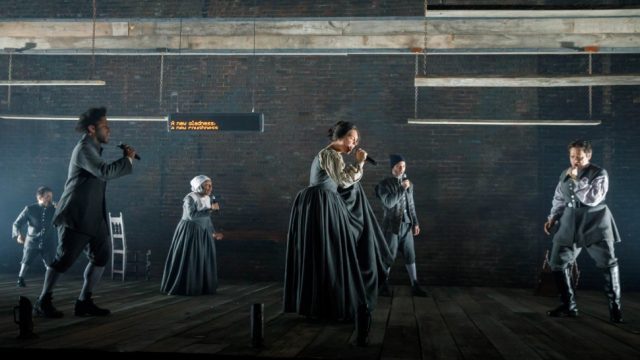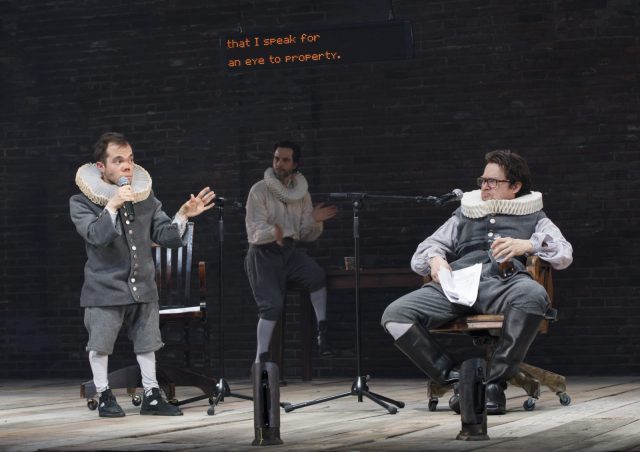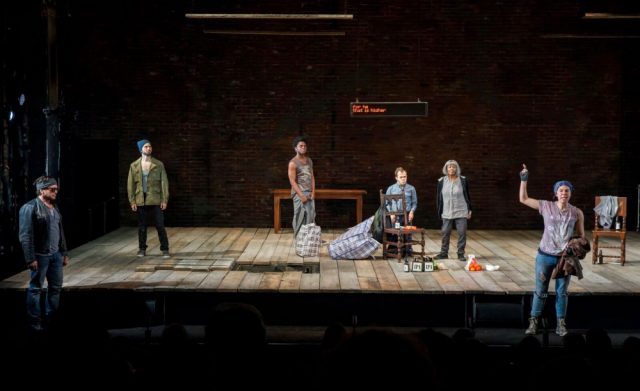
A diverse six-person cast performs Caryl Churchill’s Light Shining in Buckinghamshire at New York Theatre Workshop (photo by Joan Marcus)
New York Theatre Workshop
79 East Fourth St. between Second & Third Aves.
Tuesday – Sunday through June 3, $69
www.nytw.org
Light Shining in Buckinghamshire is the first play that New York Theatre Workshop has ever done twice, and initially it’s easy to see why. The 1976 play, written by the mighty Caryl Churchill, made its New York premiere at NYTW in 1991 and is now being revived there through June 3, in a new production directed by the sizzling hot Rachel Chavkin, the mastermind behind Hadestown, Small Mouth Sounds, Natasha, Pierre & the Great Comet of 1812, and other uniquely inventive shows. A talented, diverse cast of six performs multiple roles each, without regard to age, race, gender, or physical ability. The subject is the English Civil Wars of the seventeenth century, focusing on the rebellion involving the Diggers, the Levellers, and the Ranters, which in many ways parallels what is happening, or might happen, in the United States today. So what went wrong with this dream team?
In a production note, Churchill explains, “The audience should not have to worry exactly which character they are seeing. Each scene can be taken as a separate event rather than part of a story. This seems to reflect better the reality of large events like war and revolution where many people share the same kind of experience.” Unfortunately, only part of that concept works. Vinie Burrows, Rob Campbell, Matthew Jeffers, Mikéah Ernest Jennings, Gregg Mozgala, and Evelyn Spahr easily shift between characters on Riccardo Hernández’s spare set, a wooden platform on which various chairs and tables are moved around and taken away. But there are continuity issues; you don’t always know who someone is or what they’re doing. In other works, Churchill has magnificently shown that narrative flow is not always crucial; for example, the stunning Love and Information consists of very short scenes played by unidentified characters who arrive and depart in the blink of a strobe light. And in Cloud Nine, actors switch roles between acts, lending another level of depth to an already deep play.

Matthew Jeffers, Gregg Mozgala, and Rob Campbell in Light Shining in Buckinghamshire (photo by Joan Marcus)
To add to the tumult, in the first act the actors use handheld microphones, which perhaps was meant to bring the centuries-old story into the present but instead makes it look like any one of the characters might break into song or a comedy routine at any moment. (In fact, the play begins with a musical version of a biblical passage.) In the second act, the microphones are gone but the period costumes have been traded in for contemporary dress. (The costume design is by Toni-Leslie James.) Also, the entire show is open captioned on a small digital monitor near the back center of the stage. While it is admirable that four-time Obie winner and Olivier Award winner Churchill and three-time Obie winner and Tony nominee Chavkin want to make every word accessible to audience members with hearing difficulty, as well as emphasizing the idea of equality for all, its location is endlessly distracting. As the dialogue moves across the monitor in red LED lights, it’s hard not to look at it even if you can hear the words, your eyes caught by the movement; the monitor also displays the title of each scene — “The Vicar Talks to His Servant,” “Two Women Look in a Mirror,” “A Butcher Talks to His Customers,” for example — information that is not available elsewhere and is often necessary in order to know which characters are onstage. I’ve seen other productions that use open captioning at the side of the stage or in supertitles above, where it is far less distracting, so its positioning here is more than curious.

Caryl Churchill’s Light Shining in Buckinghamshire is first play New York Theatre Workshop has tackled for a second time (photo by Joan Marcus)
And it’s a shame, because there are many wonderful lines — particularly dealing with sin — that get lost in the theatrical commotion. “What is worst, I am not praying to you about the worst sin. I sin in my fear of praying about that sin, I sin in denying my fear,” Cobbe (based on Abiezer Coppe) bemoans in an opening monologue. “I have come to see that there is no sin but what man thinks is sin,” says Claxton (loosely based on Laurence Clarkson), who continues, “So we can’t be free from sin till we can commit it purely, as if it were no sin. Sometimes I lie or steal to show myself there is no lie or theft but in the mind.” Then there’s this gem, offered by a preacher: “It is no sin to take up arms against the king. It is no sin if we fight singing praises to God, if we fight to bind an unjust king with chains.” In writing the play, Churchill used such sources as Walt Whitman, a Levellers newspaper and letter, a Ranters pamphlet, and excerpts from the Putney Debates of 1647, which involved Col. Thomas Rainborough, private soldier Edward Sexby, Col. Nathaniel Rich, civilian John Wildman, Commissary General Henry Ireton, and eventual Lord Protector Oliver Cromwell. The different styles of language don’t always meld together; while some scenes are exceptional, others fall flat.
In many ways, the Public Theater’s recent production of Bruce Norris’s brilliant The Low Road, inspired by Adam Smith’s The Wealth of Nations and taking place shortly before the American Revolution, covered much more successfully some of the same conceptual territory: slavery, property, capitalism, politics, religion, war, poverty, and independence, and there was even a roundtable discussion using contemporary technology. In the debates, Cromwell, speaking on a proposal regarding representation in government, asks, “But how do we know another company of men shall not put out a paper as plausible as this? And not only another, and another, but many of this kind. And what do you think the consequence of that would be? Would it not be confusion? Would it not be utter confusion? As well as the consequences we must consider the ways and means: whether the people are prepared to go along with it and whether the great difficulties in our way are likely to be overcome.” The same can be asked of this production of Light Shining in Buckinghamshire, in which a more-than-plausible script results in utter confusion, and judging from the number of people who left at intermission when I saw it, not everyone was prepared to go along with it.